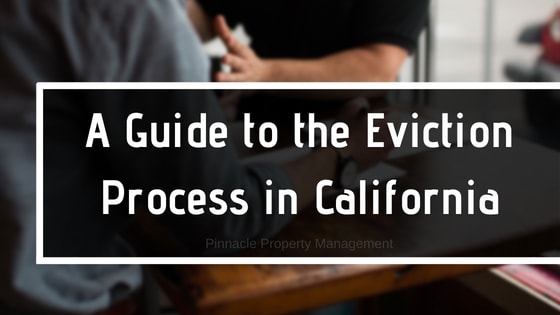
Evicting a tenant is an unfortunate part of being a landlord. The eviction process is time-consuming and oftentimes requires landlords to pay court costs or attorney's fees. But sometimes, it’s the only way to get rid of a troublesome tenant. Among other things, if a tenant violates the agreement, causes damage to the rental unit, fails to pay rent, or is using drugs in the rental property, a landlord can legally evict tenants.
California laws require landlords to legally terminate a tenancy before evicting a renter. This means “self-help” evictions should not be practiced. A landlord must follow the eviction process. Even if the tenant is months behind on rent, without a court order, landlords cannot:
- Change the rental unit's locks;
- Remove outside windows or doors;
- Cut off the utilities, like water or electricity;
- Lock the tenant or tenants out;
- Get rid of the tenant’s belongings or personal property; or worst of all
- Physically remove the tenant from the rental unit.
California Eviction Process: A Guide
The Rationale for the Rules
When a landlord wants to evict a tenant from their rental unit, the landlord must carefully follow all the rules and procedures required under the state’s rental laws. If not, the eviction may fail. While the eviction process can seem burdensome, the rules and procedures are there for a reason.
Appropriate Notice for Lease Termination with Legal Cause
A landlord can evict a tenant for various reasons. Such legal grounds include:
- Failing to pay rent
- Property damage
- Violation of the terms of lease agreements
- “Holdover” tenant
- Illegal use of the rental property
- Illegal drug manufacturing
- Illegal activity
- Causing significant disturbance to other neighbors and tenants
Prior to terminating the tenancy, a landlord must first serve the tenant with proper notice that the eviction process is starting.

The type of notice used is determined by the reason for the termination. Generally, there are three types of eviction notices that can be given. They are:
- Three-Day Notice to pay due rent. This written notice gives the tenant two options: to pay rent or leave. If the owed amount on the tenant's record is unpaid within three days, then the landlord can start the eviction proceedings against them in court.
- Three-Day Unconditional Quit Notice. Unlike the notice for a month-to-month tenancy, this notice period doesn’t give the tenant an option to remedy the violation. It simply requires the tenant to leave. If the tenant doesn’t leave within three days, then the landlord can file an eviction lawsuit against them in court.
- Three-Day Notice to Cure. This notice gives a tenant three days to correct a lease violation. For example, to cease causing disturbance to other tenants. If the tenant doesn’t do so within three days, the landlord can file an eviction lawsuit against them in court.
Notice for Lease Termination Without Legal Cause
Without a cause, procedures for evicting tenants depend on the length of the tenancy. If it’s a month-to-month lease, the California landlord-tenant law requires landlords to give the tenant a 30-day notice to end their tenancy.
If the term of the agreement is fixed, you must wait until the period is over to end the tenancy. Both notices must inform the tenant that you won’t be renewing their rental agreement for another term.
Tenant Eviction Defenses in California
A defense is a reason why you (the petitioner) shouldn’t win the case. Under California eviction laws, a tenant may claim:
- You waited far too long to start filing the lawsuit against them
- You refused to take rent
- Monthly rent being requested isn’t the one on the lease agreement
- You overcharged the rent
- The rental wasn’t habitable
Removal of the Tenant
Under California law, if the tenant fails to act on an eviction notice within the time specified, landlords can go to the court and begin filing an unlawful detainer suit with the court clerk. To successfully file the unlawful detainer lawsuit, you will require the following forms.
First, you need an unlawful detainer complaint, a civil case cover sheet, and a prejudgment right of possession form.
Next, you will need to serve the tenant with the summons and compliant. The tenant has five business days to finish filing a “response” to the court to challenge the lawsuit.
If the tenant refuses to respond, then you may win by default judgment. If the tenant responds, then they have the right to a hearing date.

At the trial date, the judge will give both you and the tenant a chance to present your cases. As such, you should collect as much evidence as possible. For example, records of lease violations, eviction notices, and the lease or rental agreement.
If you win, then the court will issue you with a Writ of Possession. This document gives the sheriff the power to forcefully evict a tenant from your rental if they fail to move out voluntarily within five days after the judgment.
Depending on the circumstances and the provisions, the court may also order the tenant to cover a $600 penalty, attorney fees, and any unpaid rent.
Sometimes, the tenant may leave some personal belongings behind. In some municipalities, you may need to notify your tenant of the items. In others, though, you may sell or dispose of them.
Eviction Process: Bottom Line
The termination and eviction process isn’t as easy as making a request to your tenant to vacate the premises. You must follow certain defined procedures during the entire process. Hopefully, this guide has been informational in this regard.
If you have specific questions, hire the services of a qualified attorney. Alternatively, you can seek help from a knowledgeable property management company.
Disclaimer: This content is for educational purposes only. For further help or legal advice, kindly consider hiring a local legal firm for legal services or seeking help from a qualified property management company.







